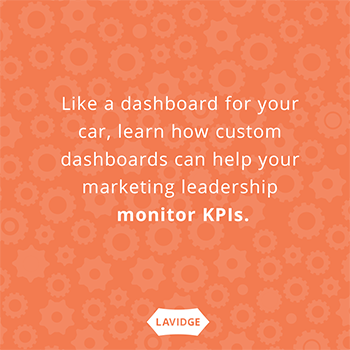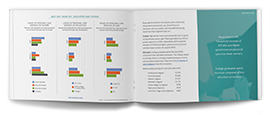Sign up for our LAVY email
and get our bi-monthly newsletter.
 Company executives are bombarded with so much marketing data it’s a wonder their heads don’t explode.
Company executives are bombarded with so much marketing data it’s a wonder their heads don’t explode.
Their inboxes are filled with dozens of reports and spreadsheets about website performance, digital and traditional advertising metrics, lead generation campaigns, social media statistics, appointment conversions, loyalty program effectiveness and countless others. Coupled with abundant information about financial health, it’s a wonder any decisions are made in a timely and strategic manner.
In the early 1900s, automobiles offered practically no performance information to operators. A steering wheel was the only thing in front of you. Even well into the ‘50s and ‘60s, cars typically featured only a water temperature gauge, fuel gauge and speedometer. Most modern car dashboards also present data about tire pressure, airbags, batteries, brake fluid and pads, coolant levels, oil level, window washer fluid, safety belts, gas caps and more. Information about these important functions is usually presented in an organized, colorful and easily understood manner.
 The same principle applies to custom marketing dashboards, which are concise visual representations about the company’s performance. Such sales and marketing dashboards are presented in a way that enables the C-suite to easily monitor the progress of marketing KPIs and objectives in a graphically appealing manner.
The same principle applies to custom marketing dashboards, which are concise visual representations about the company’s performance. Such sales and marketing dashboards are presented in a way that enables the C-suite to easily monitor the progress of marketing KPIs and objectives in a graphically appealing manner.
Dashboards are a way of communicating, simplifying and distilling complex information. While a CEO, CMO and other leadership stakeholders will certainly still want to wade through detailed documents and supporting data, a concise dashboard provides them with enough information to ask questions and affect change. The best dashboards show what’s working and what needs improvement. They compare outcomes to brand benchmarks, research and company objectives.
For many executives in the retail services industry, the advent of dashboards can’t come soon enough. In “Dying for Business,” a report by Reuters on information fatigue, 49% of business executives said they couldn’t handle the large amount of information necessary to perform well. And 43% said their decisions were delayed and compromised when attempting to absorb too much data.
Dashboards are a necessity for regional or national personal care or retail services companies that have several locations. If you own a chain of 200 nutrition stores, you’d need to know how each location is performing. You’ll want to see data on how store microsites are ranking for key search terms and how many appointments have been booked.
Also, it’s not uncommon for retail service or franchise companies to have several different dashboards, each focusing on a specific marketing initiative such as measuring website traffic, organic search, social media and paid search advertising metrics.
Although it’s been attributed to several management gurus, I’ll give the late Peter Drucker credit for observing that “What gets measured gets improved.” If that maxim is true (and it is) then dashboards are the key to affecting a company’s performance at all levels. According to Dave Lavinsky, author of Start at the End: How Companies Can Grow Bigger and Faster by Reversing Their Business Plan, “When employees know their performance is being judged in a dashboard, and can see their results, they innately start to improve their work.”
The key to a great retail services dashboard is ensuring that it measures only things that matter. Many dashboards focus on vanity statistics that are easy to obtain from a customer relationship management system (CRM) but that don’t help move the needle. High-level data such as total website traffic and social media followers are good to know, of course, but they aren’t as effective as knowing how many appointments were made online, trends about consumer reviews, and local search effectiveness.
No two retail services companies are alike, and neither are their leadership teams. That’s why the best dashboards allow customization for every business and for each executive. A cookie-cutter approach won’t do, and an off-the-shelf dashboard system is likely to be insufficient and therefore will gather dust.
The best dashboards are hand-crafted around a company’s culture, objectives and internal decision-making stakeholders. And the more current the data, the more likely they are to be referenced and utilized. There’s nothing worse than a marketing dashboard with moldy numbers. Optimally, a dashboard will feature real-time data captured with marketing automation software. When employees input data, problems related to human error increase.
Finally, dashboards should be created and treated as factual entities that are inoculated against subjective interpretation. Dashboards must speak for themselves. President John Adams said, “Facts are stubborn things.” That’s what makes dashboards so valuable to your analytics strategy; they present unvarnished factual evidence of what’s working and point the way toward change.
Not sure where to start? You’re not alone. LAVIDGE experts in analytics can help you navigate the process of setting up an effective dashboard for your retail services business or franchise.
To learn more, give our full-service digital agency a call at 480.998.2600 or send email to info@lavidge.com.
If you’re getting serious about creating excellent dashboards, here are some mistakes to avoid, courtesy of Tableau software.
1. Starting off with too much complexity.
2. Using metrics no one understands.
3. Cluttering the dashboard with unimportant graphics and unintelligible widgets.
4. Waiting for complex technology and big business intelligence deployment projects.
5. Underestimating the time or resources to create and maintain the dashboard.
6. Failing to match metrics to the goal.
7. Using ineffective, poorly designed graphs and charts.

This article is a brief abstract of our exclusive and authoritative study that takes the guesswork out of health, beauty and grooming retail services advertising and marketing. Rather than speculating about what will drive consumers to action, we've asked them.
Sign up for our LAVY email
and get our bi-monthly newsletter.